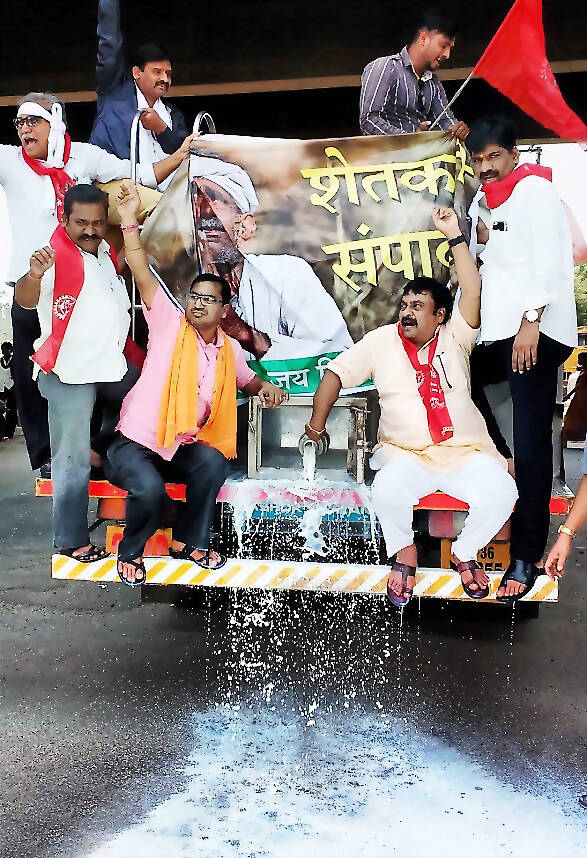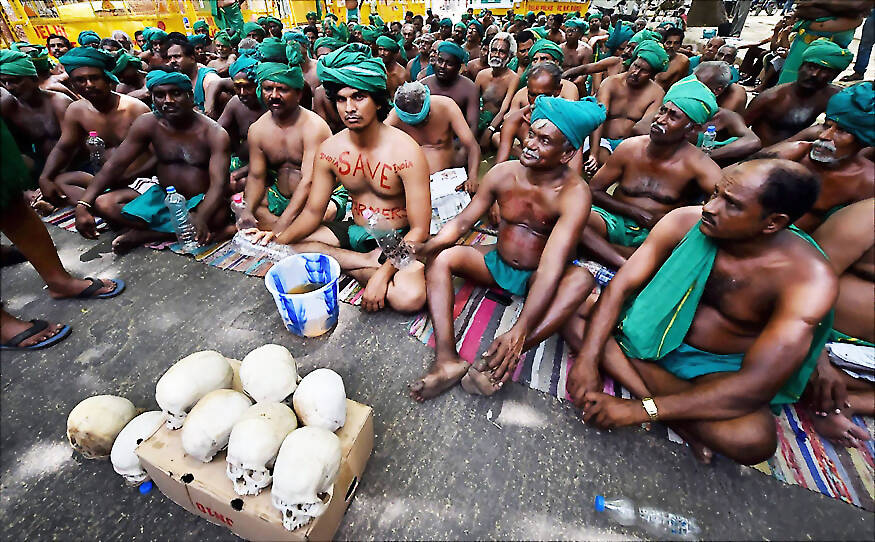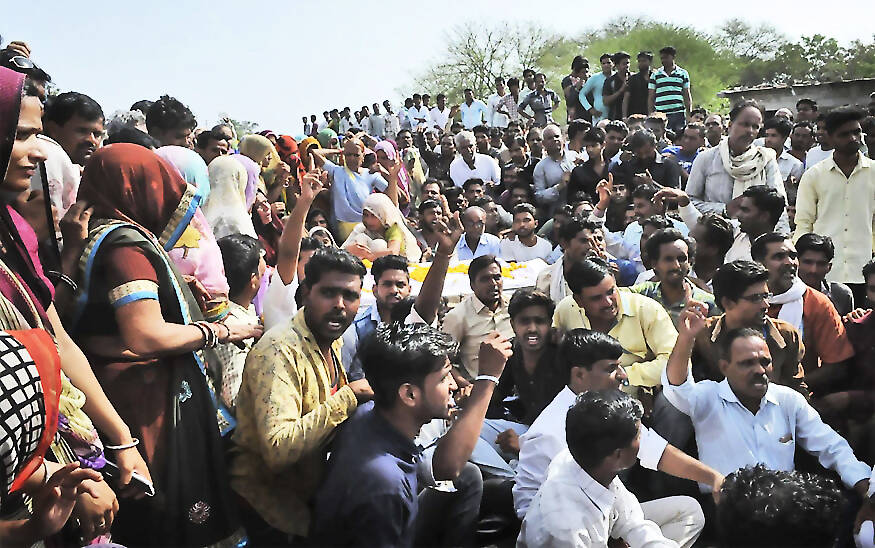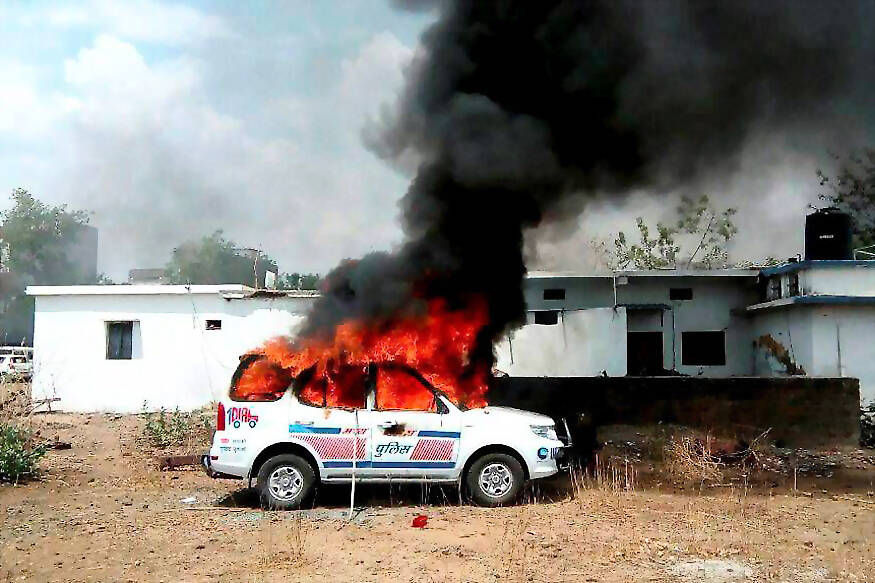
views
Nagpur: Irony could not have been lost on the state of Madhya Pradesh.
It recently became India's first state to open a happiness department—ostensibly to gauge how happy people were under Chief Minister Shivraj Singh Chouhan's regime.
On Tuesday, it became the first state in the recent history of the country to shoot six farmers dead in its north-western district of Mandsaur, a hub of pulses, soybean and spices.
Chouhan first blamed “the anti-social elements” for violence and later said farmers "had been misled". His Home Minister Bhupendra Singh immediately denied police had opened fire at protesters, but later confessed, though reluctantly, that “the police may have fired in self-defence at one place.”
This came after a weeklong largely peaceful protests by the peasants who were demanding a complete farm loan waiver and remunerative prices for their produce. The markets were paralyzed across the state, more so in Mandsaur.
Happiness just went bust in MP, and gauging the mood — that the police had wrongly rubbed the already sore Patidar (landlord) community scattered across the western regions — Chouhan quickly loosened the strings of the state treasury to announce a whopping Rs 1 crore compensation and a government job to the next kin of each of the dead farmers.
In a searing hurry to tame the situation, the CM has reportedly also agreed to confer the six deceased farmers with a 'martyr' tag — whatever it means.
A judicial commission of inquiry would now find out what happened, and buy time for the CM.
Mandsaur, meanwhile, remains on its toes. Its district collector was heckled by the agitators on Wednesday, and the Congress leaders were detained before they could join the agitation.
 Mandsaur on the map (Image: News18.com)
Mandsaur on the map (Image: News18.com)
Remember, this is a state that claims its agri-GDP to be consistently high at over 10 per cent. Madhya Pradesh has joined the league of Punjab and Haryana in food-grain production as the Narmada waters have begun to transform the once dry southern belt into a green, food-grain bowl of the state.
Yet, the farmers' protests have been sweeping the state over the last week. And the northern dry and arid regions like Mandsaur have been at the forefront, given the complete collapse of rural economy. It is also a region where the Patidars (Patels), or big land holders, are a dominant community. And like the Marathas in Maharashtra, the Patidars in Gujarat, Rajasthan and MP are ruing at the fact that in the last 30 years — post Mandal, post liberalisation — they have lagged behind others, who have managed to uplift themselves through service economy despite being socially backward.
Beyond Madhya Pradesh
Back in Maharashtra, the 'Kisan-Hadtal' or farmers' strike enters sixth day, even as Devendra Fadnavis, the state’s chief minister, has announced his desire to waive off the loans only of small and marginal farmers before October 31. He has made it clear that a blanket waiver isn't possible. Even a partial loan waiver, he told reporters two days ago, would cost the state’s exchequer a whopping Rs 30,000 crore.
Nearly 40 farmers' organisations, including some that had backed the BJP in 2014, the NCP and the Congress, and even the BJP ally Shiv Sena, are steering and supporting the farmers’ strike.
Wholesale markets are affected; vegetables prices in the cities are surging, and milk is being brought to the cities in tankers from private and state-run dairies under police protection.

Deep South, in Tamil Nadu, the drought-hit farmers are in dire straits; their protests that were called off last month in New Delhi, could be reignited any time.
Calls for a total farm loan waiver are becoming shriller in other states too — the BJP has asked the Congress government in Karnataka to waive off the farm loans, even as it denies it in MP, Maharashtra, and other states that it rules.

Things have come to a boil on the farm front — this, at the end of a season that was one of the best in terms of monsoon, production and productivity after years of droughts. In Punjab too, the new government sits tight; it too had promised a loan waiver before Assembly elections.
How UP's loan waiver opened can of worms
As the rage spilled over in a small village in Mandsaur in the north-eastern Madhya Pradesh, with the police allegedly opening fire and killing at least six protesting farmers on Tuesday, the country woke up to a crisis that has been simmering in Maharashtra for almost a week. Other states much watch out.
Prime Minister Narendra Modi has cleverly ducked what is essentially his liability and pushed it on to the states that can’t deal with the impending crisis and have no financial resources to write off the farm loans.

If Chouhan and Fadnavis are to put the blame of the unrest in their states, it has to be on the Centre that has watched the unfolding chaos with glee. It began with the BJP's central establishment allowing Yogi Adityanath government to announce a loan waiver in Uttar Pradesh under the pretext that it was the party’s election promise, opening a can of worms for the other states, but leaving to the respective states the call on farm loan waiver.
On Tuesday, former Union agriculture minister Sharad Pawar told the reporters after his meeting with the PM that Modi was not for a loan waiver; it was a decision that the respective states must take and foot the bill. The UP decision was only limited to that state.
The simmering unrest in the countryside is the symptom of a deeper socio-economic crisis lingering for almost two decades — a realisation in the farming households that they have lagged behind others in economic wellbeing since the process of liberalisation began in 1991. The immediate trigger, however, lies in the crash in farm commodity prices in the 2016-17 and a total collapse of rural informal economy in the wake of demonetisation, which is beginning to hurt the agrarian masses ahead of a fresh farming season.
They have no liquidity and the burden of unpaid debt is mounting.
The new summer, coinciding with the completion of three years of Modi government, has come with the haunting old question for the farmers: What do you grow that gives you guaranteed good returns?
Bitter lessons from the year gone by
As the new farm season sets itself on the beleaguered, indebted, sullied and fatigued farming masses across the country, the year gone by tells us three things.
One: Bumper production does not always mean profits. As the tomato, onion, red gram, or paddy-wheat-cotton farmers would tell you. Or those growing oranges or sweet limes!
Two: Monsoon, even when it is bountiful, does not necessarily bring in relief for the peasantry.
Three: Drought is not only a water-food-productivity crisis. It exists even when there’s abundance. And it's today an inseparable element of an unequal, uncertain world.
Almost every crop – including fruits – sold at record low prices in 2016-17 and neither the Centre nor the states intervened to stem the free fall of the commodity prices.
Soybean prices plummeted to an all-time low in October-November — from nearly Rs 6,000 a quintal in 2015-16 (a year when productivity was abysmal) to Rs 2,300 in 2016-17 (when production was bumper); perishables were about to enter the markets when Modi demanded a sacrifice through demonetization.
Result: Vegetable prices across India collapsed to such lows that the growers ran tractors over standing tomato crops, threw them on the roads, or sold the commodities at massive losses.
Urban consumers continued to pay higher prices. Retailers and wholesalers made merry and pocketed profits not seen in the last decade.
Cotton prices held on to a little over the minimum support prices, but only just. Today even those prices are falling as rupee appreciates.
The last hope was Redgram or Tur, the poor man's protein. Before the new crop flooded markets — and it was a bumper production year, the government opened the 'Tur' imports glutting the local markets and gutting the domestic producers. Several lakh tonnes of 'Tur' is lying in agricultural produce market committee (APMC) markets in Maharashtra, waiting to be procured by reluctant central agencies like NAFED at a minimum support price.
In the open markets prices hover around Rs 3,000/quintal. Compare that with the last year's average Rs 10,000/quintal. This was the first year in the past many years when the beleaguered farmers reaped a bumper yield, particularly in central India. But they were doomed by the markets that gave them no prices and a state that was non-responsive. Latest to suffer price slump is the sweet lime: The prices last year hovered around Rs 15,000 per tonne. This year they are at Rs 3-5,000 per tonne.
In Maharashtra, in Madhya Pradesh, and elsewhere Tur prices are below the support prices. In the APMCs, where the NAFED stepped in to buy the crop a tad late, the farmers are waiting for the agency to buy their crop and pay them their money. The waiting period is anywhere between a month and 45 days.
In Washim district of Maharashtra, farmers were made to line up to get their tokens at APMC markets to sell their 'Tur' produce, as the state government finally got an extension from the Centre to buy more produce from the farmers through NAFED. The long queues of disparaging farmers in the simmering summer temperature forced the district administration to press for the deployment of police — thankfully not the army — at markets to control the mobs.
Chilly prices — like that of all other commodities — sank to their lowest in a decade as a bumper crop led to a glut; the growers in Andhra and Telangana burnt their crops in disgust.

With prices crashing by 60 per cent over the last year to Rs 3,500-5,000 a quintal and cold storages already overflowing with the produce, the Andhra government recently announced a price support scheme of Rs 15/kg for farmers, till June-end, but with a catch that each farmer will get this support for a maximum of 20 quintal (2,000 kg). The scheme came much too late, when the growers had already sold nearly 70 per cent of their produce to private traders in the open markets at depleted prices.
In the southern states, things have come to a naught, as prevailing drought rips through the socio-economic fabric, pushes migrations, and triggers chaos.
State of hopelessness
Now add to this, the near neglect of rural off-farm economy: the MGNREGA, which is now tied to the Aadhaar, is sluggish in its implementation. The real estate sector, which would have provided some off-farm work to the migrating rural labour, is yet to pick pace after the demonetisation assault.
There is no work to be found in small towns, leave aside rural areas, notwithstanding the government's three-year celebration prop.
Back on the arid farms, the tiller wonders which crop could fetch him guaranteed good returns next year. It's futile to ask this question, the farmer knows. He asked himself the same question last year, and the year before. And ultimately went back to planting what he did the many years. The farmer is worried: How do you break even, leave aside the lofty idea of doubling the farm incomes by 2022.
















Comments
0 comment